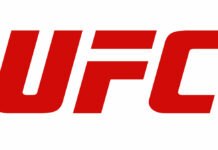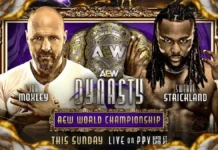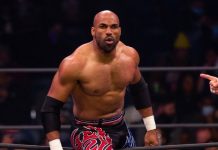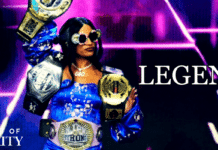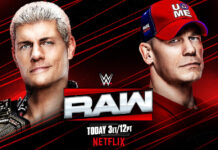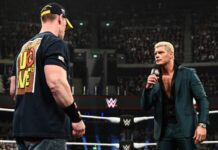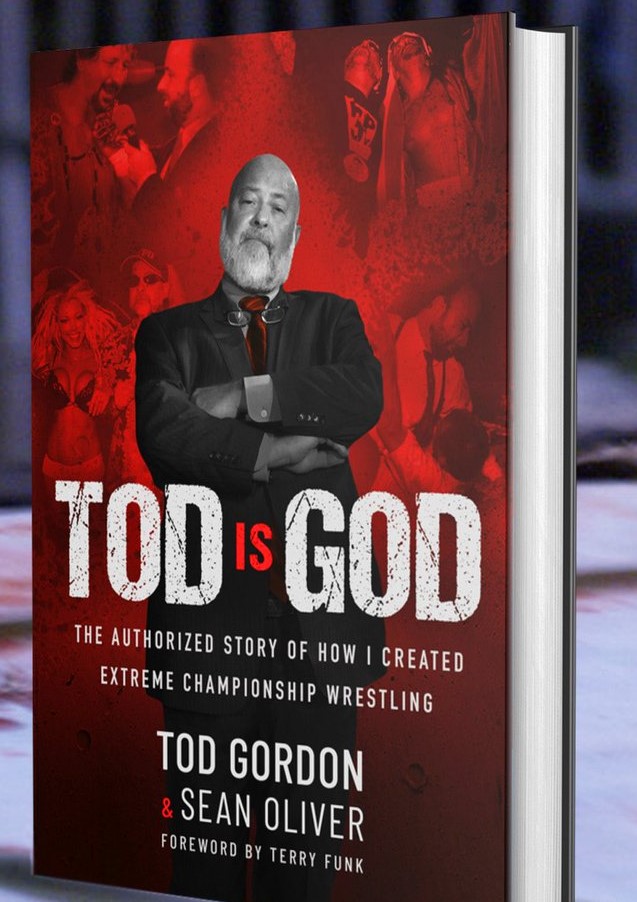
Professional wrestling, the spectacle that blends the athleticism of sport and the drama of theater, remains a staple of the American entertainment industry. A genre that originated from the carnival circuit, sports entertainment often finds itself in the “truth is stranger than fiction” category. Perhaps, that’s because the narrative that unfolded in front of camera was sometimes tame compared to the drama behind the curtain. It certainly takes some very unique individuals to work in this very unique field.
One of the ways that pro wrestling kept fans heading to the box office was that the sport was usually contemporary, a reflection of the times, and when it wasn’t, there was a dose of adrenaline ready to push the business in a new direction. Sure, Bruno battled the foreign menaces as a reflection of cold war tensions, and Rock N’ Wrestling formed a very successful tag team with the newly-created MTV in the 80s, but the steroid scandals of the early-90s forced Vince McMahon, the emperor of sports entertainment, to soften his product to attempt to rehab the image of his organization. World Championship Wrestling, a Ted Turner purchase after Jim Crockett Promotions unknowingly spent itself into bankruptcy, had a revolving door of figureheads that, at that time looked to follow the cartoonish blue print of Stamford.
Plumbers, trash collectors, Ding Dongs, and Dynamic Dudes littered the landscape of an industry that had Roddy Piper scorching foes on the mic, while Ric Flair often sported crimson in his trademark bleach-blond hair en route to winning championships just a few years earlier.
What happened next is one of the most covered and arguably over analyzed aspects of the history of the industry. Extreme Championship Wrestling, the renegade organization that was based in South Philadelphia, changed the presentation of the entire industry forever. It was fast-paced, hard-hitting, and violent. It had a rabid fan base that elevated the expectations of the audience. There were intriguing characters, storylines that had the audience invested, and a cutting-edge product that pushed the envelope. It was no surprise that the two big leagues of the WWF and WCW borrowed liberally from the extreme playbook, both for concepts and talent, in the Monday night war that generated record-setting television ratings during the era.
Since ECW was so impactful, and the rise was just as fast as the fall, everyone offered an opinion on the era of extreme. There were authorized DVDs, unauthorized DVDs, the official story in print, the unofficial story in print, and was the subject of more podcast clips than The Sandman usually had beers on the way to the ring.
So, the story of Extreme Championship Wrestling was told, or was it?
It’s often said that the victors write the history books. When the slug fest of the 90s wrestling boom ended, just like the 80s in the previous generation, there were casualties of the wrestling war. The same way the regional territories evaporated, WCW was sold to Vince McMahon for pennies on the dollar just two months after ECW filed for bankruptcy, crumbling under the pressure of the industry. McMahon bought the rights to ECW and its video library out of bankruptcy court by 2003. As mentioned, a slew of projects told the narrative of the extreme organization, with the Stamford spin, of course.
Before he was the wise man for the tribal chief, Paul Heyman was showcased through the WWE narrative as the mad scientist behind the wrestling revolution that was ECW, but if Paul Heyman was the architect of extreme, Tod Gordon, who originally started the group, laid the foundation of what became hardcore in America.
Gordon, who exited ECW in late-1997, will finally tell his side of the story of not only how the company was actually founded, but his role in the organization, an aspect of the narrative that was often glossed over previously. Tod teamed up with Sean Oliver, one of the co-founders of the Kayfabe Commentaries production series, to put pen to paper for the newly-released autobiography, “Tod is God,” a literary look at his role in the company that left such a foot print on the industry that the three letters are still chanted in arenas today.
When I caught up with Tod via phone to discuss the publication, he was relaxing at home on a Saturday afternoon after his usual routine during the week, the same routine that he has done for nearly four decades, working in his jewelry store in the heart of Philadelphia.
“I get up early in the morning, put on the suit and tie to go to the store, and work. Work hard, play hard,” Gordon said.
Like so many in the north east, Tod fell in love with the blue collar style of the WWWF. Bruno, Kowalski, and Albano were just a few of the grapplers that fueled his fandom of the squared circle. Also like many, by the early-90s Tod was just as disenfranchised as many others and looked to provide some type of alternative, at least on a local level, to the silliness that found its way on national television.
“I was sick of what I was seeing on TV at the time. WWF had become all cartoons, they even had a Saturday morning cartoon. The pig farmer, the dumpster, and Papa Shango. It took all the believability and the enjoyment out of wrestling. I watched as a kid, I believed what I saw. I believed Bruno was beating this guy, I believed everything I saw. I wanted to go back to that era, and the only way to do that was to start my own company and put on those kind of shows. Every show I put on from the day I started until the day I stopped, I put on the kind of show that I wanted to see,” Tod explained.
Gordon spent two or three hours at a time a few times a week on Zoom with Sean Oliver, telling the stories of how he became involved the pro wrestling game. Oliver, who worked in film, television, voice-acting, and directing during his career, also penned half a dozen books before he took on the life story of one of the engineers of extreme.
“Sean told me ‘you have to do a book, you have to do a book.’ and after I did two DVDs with him, we become friendly and got along really well. We’d be on the phone and I’d tell him a story, and he’d say ‘you gotta put that in the book.’ He did a fantastic job putting it all together, it felt like I was just talking to a friend,” Gordon said.
Throughout the pages of “Tod is God,” readers will not only hear the details of how Missy Hyatt found herself on top of a jewelry case in Tod’s store, but also how that meeting led to his involvement in Joel Goodhart’s short-lived Tri-State Wrestling Alliance. More specifically, as you turn the pages, you will uncover the details of how Eastern Championship Wrestling was eventually founded from the ashes of the Tri-State organization.
What started as a side project in front of 80 people at a sports bar soon grew into a touring organization, as within two years the upstart league branched out to other towns based on the television show that ran at 6 PM every Tuesday night on Sports Channel Philadelphia. On top of his full-time work at the jewelry store, Tod took on the promotional and funding side of ECW, duties that saw him close up shop on Friday afternoons to be picked up by The Sandman, Bill Alfonso, and Too Cold Scorpio to go on the road for that weekend’s loop of events. Tod still keeps in touch with that same group of friends today, talking to each of them at least once a week.
“It was like making the switch between Clark Kent and Superman, just two completely different worlds,” Tod remarked as to the comparison between his two very unique professions.
After Tod arrived to places like Jim Thorpe, Pennsylvania, he often ran around dingy venues to coordinate the lights, sound, and structure of the show that night, finding himself drenched in sweat since the buildings had no air conditioning before he went to the ring himself for his on-screen role as the commissioner of the organization. However, through the humidity, jam-packed schedule, and office work, a particular night stood out to him as an indication that the product that was famous for its bingo hall home base had a major impact on the sport.
“The time I knew we had something big going was the three way dance with Funk, Sabu, and Shane Douglas. It was the first three-way dance done in wrestling, nobody had ever done that before. After the show, Paul and I pulled up to the hotel, and there were hundreds of fans outside chanting ‘thank you Paul, thank you Tod.’ We looked at each other said we thought we had something hot here. I know that was something that was important and something that was going to grow,” Tod remarked.
Naturally, with the impression that the product made on the fans, there was an opportunity to grow, and different from the media deals of today, pay-per-view was still king as the biggest revenue stream possible in pro wrestling. However, to market and advertise the product on a level that made pay-per-view possible, expenses to get ECW television added to key channels like the MSG network in New York, and The Sunshine Network in Florida added a heavy financial weight on the grassroots organization, a financial burden that was ultimately shouldered by Tod.
“The debt was overwhelming us. Getting on pay-per-view, you have to put up $250,000 and then you don’t get the money from that until six or eight weeks later, but then you have to put up another $250,000 for the next pay-per-view before that. That had to come from me, that was my money,” Gordon explained.
By late-1997, Tod knew that to keep the company afloat, outside investors or new partners would be needed to bridge the gap between the expenses of pay-per-view and the eventual revenue from cable provides that those broadcast generated, but Gordon cites Paul Heyman’s resistance to that as one of the reasons that he decided it was time to step away from the industry, especially given the increased expenses and added pressure as the organization tried to go toe-to-toe with the multi-million dollar companies of WWF and WCW during the Monday night wars of the era.
“The locker room was fractured at that point. I just couldn’t do what I was being asked to do. The reason I got along with the boys so well was that I never lied to the wrestlers,” Gordon said of the tension behind the scenes prior to his exit from the organization.
In the nearly three decades since Tod turned over his stake in ECW to Paul Heyman, the infamous “mole” story made the rounds in pro wrestling lure. The narrative suggested that Gordon looked to take a core group of ECW talent to WCW for a quick payoff to leave the group he founded behind. With Sean Oliver clacking away at the keyboard, Tod tells his side of the story of his extreme exit in the autobiography, shedding light on new details that have never been uncovered before. Gordon looks to clear up the misnomers around of how he left, and also the revelation of plans that were made for a possible return.
“The untruths have been exposed, it took thirty years, nobody knew what it was. Hopefully, through the book, people can finally understand what happened,” Tod said.
After dabbling with a few pro wrestling ventures in the early-2000s, Gordon left the industry behind. These days, instead of promoting barbed wire and violence, his greatest joy is being a grandfather. Still, the publication of “Tod is God,” a moniker that was originally chanted by those diehard fans that packed those dingy building because of a shared passion for pro wrestling, gave him the chance to reflect on the profound impact that he had on the industry that brought him such joy since his youth. Despite the ups and downs, it’s still a journey that Tod Gordon looks back on fondly.
“The memories just came flooding back it was overwhelming, Tt’s so humbling that thirty years later that people still chant ECW, that’s mind-blowing,” Gordon concluded.
To order Tod’s book, you can go to https://www.amazon.com/Tod-God-Authorized-Championship-Wrestling-ebook/dp/B0BZWRH3QL
What do you think? Share your thoughts, opinions, feedback, and anything else that was raised on Twitter @PWMania and Facebook.com/PWMania.
Until next week
-Jim LaMotta
E mail [email protected] | You can follow me on Instagram, Facebook, & Threads @jimlamotta89

